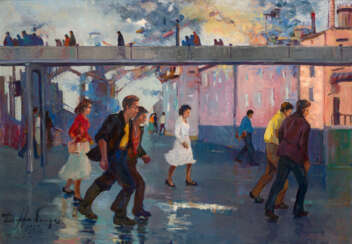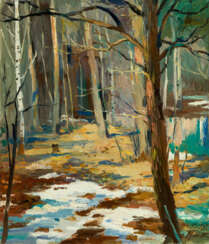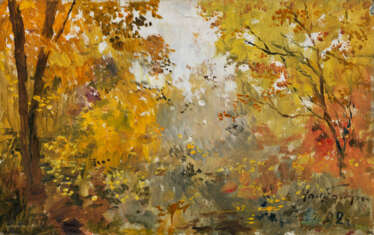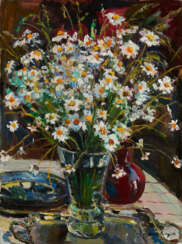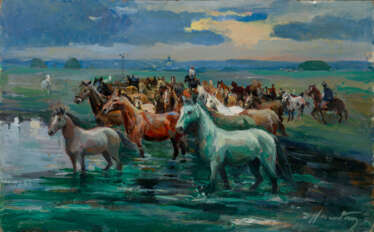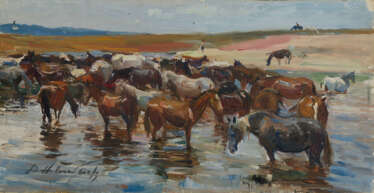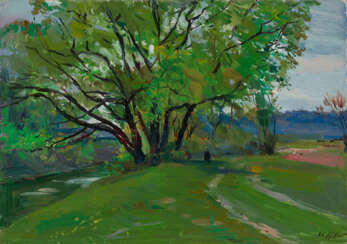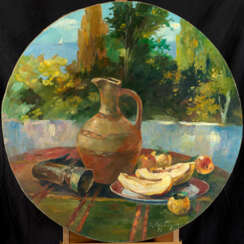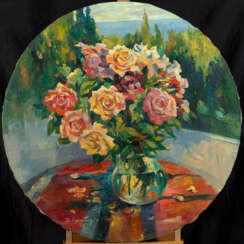dmitry arkadievich nalbandyan (1906 - 1993)
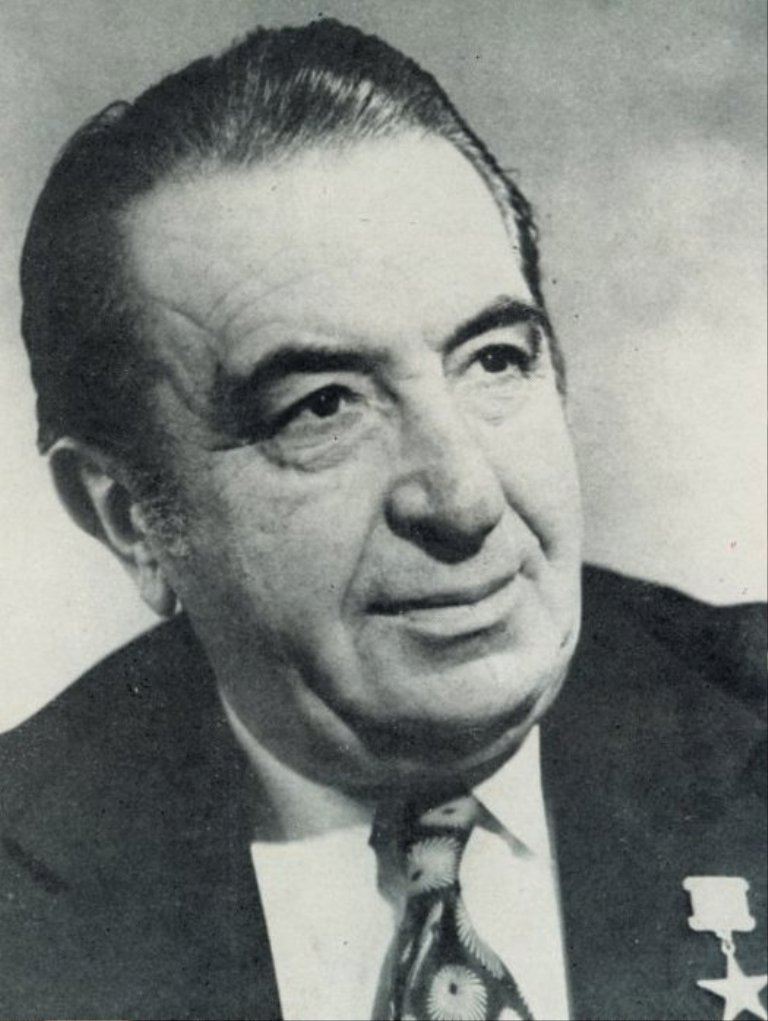
Dmitry Arkadievich Nalbandyan (Russian: Дмитрий Аркадьевич Налбандян) was a Soviet and Armenian painter, whose work earned him significant recognition including the Stalin Prize and the title of People's Artist of the USSR. Born in Tiflis (now Tbilisi, Georgia) in 1906 and passing away in Moscow in 1993, Nalbandyan's contributions to the art world were profound, spanning across genres such as portraiture, landscape, and political art. His education began in Moisei Toidze’s art studio and continued at the Academy of Arts in Tiflis, laying the foundation for a career that would see his works displayed in some of the most prestigious museums globally, including the State Tretyakov Gallery and the Uffizi Gallery in Florence.
Nalbandyan’s art was deeply intertwined with the political and social fabric of his time, with several of his works focusing on significant political figures and moments in Soviet history. For example, his portrait of Joseph Stalin and his depiction of Lenin speaking on the Red Square are indicative of his engagement with the political climate of the USSR. His artworks, characterized by their realism and attention to detail, have been celebrated for capturing the essence of their subjects and the spirit of an era. Notably, Nalbandyan was awarded not only for specific portraits but also for contributions to exhibitions and for paintings that reflected the ethos of friendship, peace, and Soviet achievements.
His artistic legacy is preserved through his contributions to major exhibitions and his inclusion in the collections of museums such as the Russian Museum, highlighting works like "At the Crimea Conference" and "For the Happiness of the People". These pieces, along with others like "Lenin speaking on the Red Square in 1919," underscore Nalbandyan’s role in documenting and interpreting Soviet history through art.
For collectors and experts in art and antiques, Nalbandyan's works offer a window into the Soviet era's visual culture, embodying the aesthetics, ideologies, and historical moments of the time. His paintings, whether they depict political leaders, scenic landscapes, or everyday life, continue to attract attention for their historical significance and artistic merit.
To stay updated on exhibitions, sales, and auctions featuring Dmitry Arkadievich Nalbandyan's art, signing up for updates can provide enthusiasts and collectors with timely information on opportunities to engage with his work. This subscription is an essential tool for those interested in Soviet-era art, offering insights and access to the remarkable legacy of one of the era's most significant artists.
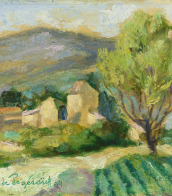

Dmitry Arkadievich Nalbandyan (Russian: Дмитрий Аркадьевич Налбандян) was a Soviet and Armenian painter, whose work earned him significant recognition including the Stalin Prize and the title of People's Artist of the USSR. Born in Tiflis (now Tbilisi, Georgia) in 1906 and passing away in Moscow in 1993, Nalbandyan's contributions to the art world were profound, spanning across genres such as portraiture, landscape, and political art. His education began in Moisei Toidze’s art studio and continued at the Academy of Arts in Tiflis, laying the foundation for a career that would see his works displayed in some of the most prestigious museums globally, including the State Tretyakov Gallery and the Uffizi Gallery in Florence.
Nalbandyan’s art was deeply intertwined with the political and social fabric of his time, with several of his works focusing on significant political figures and moments in Soviet history. For example, his portrait of Joseph Stalin and his depiction of Lenin speaking on the Red Square are indicative of his engagement with the political climate of the USSR. His artworks, characterized by their realism and attention to detail, have been celebrated for capturing the essence of their subjects and the spirit of an era. Notably, Nalbandyan was awarded not only for specific portraits but also for contributions to exhibitions and for paintings that reflected the ethos of friendship, peace, and Soviet achievements.
His artistic legacy is preserved through his contributions to major exhibitions and his inclusion in the collections of museums such as the Russian Museum, highlighting works like "At the Crimea Conference" and "For the Happiness of the People". These pieces, along with others like "Lenin speaking on the Red Square in 1919," underscore Nalbandyan’s role in documenting and interpreting Soviet history through art.
For collectors and experts in art and antiques, Nalbandyan's works offer a window into the Soviet era's visual culture, embodying the aesthetics, ideologies, and historical moments of the time. His paintings, whether they depict political leaders, scenic landscapes, or everyday life, continue to attract attention for their historical significance and artistic merit.
To stay updated on exhibitions, sales, and auctions featuring Dmitry Arkadievich Nalbandyan's art, signing up for updates can provide enthusiasts and collectors with timely information on opportunities to engage with his work. This subscription is an essential tool for those interested in Soviet-era art, offering insights and access to the remarkable legacy of one of the era's most significant artists.
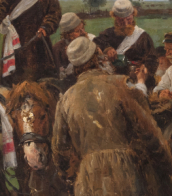

Dmitry Arkadievich Nalbandyan (Russian: Дмитрий Аркадьевич Налбандян) was a Soviet and Armenian painter, whose work earned him significant recognition including the Stalin Prize and the title of People's Artist of the USSR. Born in Tiflis (now Tbilisi, Georgia) in 1906 and passing away in Moscow in 1993, Nalbandyan's contributions to the art world were profound, spanning across genres such as portraiture, landscape, and political art. His education began in Moisei Toidze’s art studio and continued at the Academy of Arts in Tiflis, laying the foundation for a career that would see his works displayed in some of the most prestigious museums globally, including the State Tretyakov Gallery and the Uffizi Gallery in Florence.
Nalbandyan’s art was deeply intertwined with the political and social fabric of his time, with several of his works focusing on significant political figures and moments in Soviet history. For example, his portrait of Joseph Stalin and his depiction of Lenin speaking on the Red Square are indicative of his engagement with the political climate of the USSR. His artworks, characterized by their realism and attention to detail, have been celebrated for capturing the essence of their subjects and the spirit of an era. Notably, Nalbandyan was awarded not only for specific portraits but also for contributions to exhibitions and for paintings that reflected the ethos of friendship, peace, and Soviet achievements.
His artistic legacy is preserved through his contributions to major exhibitions and his inclusion in the collections of museums such as the Russian Museum, highlighting works like "At the Crimea Conference" and "For the Happiness of the People". These pieces, along with others like "Lenin speaking on the Red Square in 1919," underscore Nalbandyan’s role in documenting and interpreting Soviet history through art.
For collectors and experts in art and antiques, Nalbandyan's works offer a window into the Soviet era's visual culture, embodying the aesthetics, ideologies, and historical moments of the time. His paintings, whether they depict political leaders, scenic landscapes, or everyday life, continue to attract attention for their historical significance and artistic merit.
To stay updated on exhibitions, sales, and auctions featuring Dmitry Arkadievich Nalbandyan's art, signing up for updates can provide enthusiasts and collectors with timely information on opportunities to engage with his work. This subscription is an essential tool for those interested in Soviet-era art, offering insights and access to the remarkable legacy of one of the era's most significant artists.


Dmitry Arkadievich Nalbandyan (Russian: Дмитрий Аркадьевич Налбандян) was a Soviet and Armenian painter, whose work earned him significant recognition including the Stalin Prize and the title of People's Artist of the USSR. Born in Tiflis (now Tbilisi, Georgia) in 1906 and passing away in Moscow in 1993, Nalbandyan's contributions to the art world were profound, spanning across genres such as portraiture, landscape, and political art. His education began in Moisei Toidze’s art studio and continued at the Academy of Arts in Tiflis, laying the foundation for a career that would see his works displayed in some of the most prestigious museums globally, including the State Tretyakov Gallery and the Uffizi Gallery in Florence.
Nalbandyan’s art was deeply intertwined with the political and social fabric of his time, with several of his works focusing on significant political figures and moments in Soviet history. For example, his portrait of Joseph Stalin and his depiction of Lenin speaking on the Red Square are indicative of his engagement with the political climate of the USSR. His artworks, characterized by their realism and attention to detail, have been celebrated for capturing the essence of their subjects and the spirit of an era. Notably, Nalbandyan was awarded not only for specific portraits but also for contributions to exhibitions and for paintings that reflected the ethos of friendship, peace, and Soviet achievements.
His artistic legacy is preserved through his contributions to major exhibitions and his inclusion in the collections of museums such as the Russian Museum, highlighting works like "At the Crimea Conference" and "For the Happiness of the People". These pieces, along with others like "Lenin speaking on the Red Square in 1919," underscore Nalbandyan’s role in documenting and interpreting Soviet history through art.
For collectors and experts in art and antiques, Nalbandyan's works offer a window into the Soviet era's visual culture, embodying the aesthetics, ideologies, and historical moments of the time. His paintings, whether they depict political leaders, scenic landscapes, or everyday life, continue to attract attention for their historical significance and artistic merit.
To stay updated on exhibitions, sales, and auctions featuring Dmitry Arkadievich Nalbandyan's art, signing up for updates can provide enthusiasts and collectors with timely information on opportunities to engage with his work. This subscription is an essential tool for those interested in Soviet-era art, offering insights and access to the remarkable legacy of one of the era's most significant artists.


Dmitry Arkadievich Nalbandyan (Russian: Дмитрий Аркадьевич Налбандян) was a Soviet and Armenian painter, whose work earned him significant recognition including the Stalin Prize and the title of People's Artist of the USSR. Born in Tiflis (now Tbilisi, Georgia) in 1906 and passing away in Moscow in 1993, Nalbandyan's contributions to the art world were profound, spanning across genres such as portraiture, landscape, and political art. His education began in Moisei Toidze’s art studio and continued at the Academy of Arts in Tiflis, laying the foundation for a career that would see his works displayed in some of the most prestigious museums globally, including the State Tretyakov Gallery and the Uffizi Gallery in Florence.
Nalbandyan’s art was deeply intertwined with the political and social fabric of his time, with several of his works focusing on significant political figures and moments in Soviet history. For example, his portrait of Joseph Stalin and his depiction of Lenin speaking on the Red Square are indicative of his engagement with the political climate of the USSR. His artworks, characterized by their realism and attention to detail, have been celebrated for capturing the essence of their subjects and the spirit of an era. Notably, Nalbandyan was awarded not only for specific portraits but also for contributions to exhibitions and for paintings that reflected the ethos of friendship, peace, and Soviet achievements.
His artistic legacy is preserved through his contributions to major exhibitions and his inclusion in the collections of museums such as the Russian Museum, highlighting works like "At the Crimea Conference" and "For the Happiness of the People". These pieces, along with others like "Lenin speaking on the Red Square in 1919," underscore Nalbandyan’s role in documenting and interpreting Soviet history through art.
For collectors and experts in art and antiques, Nalbandyan's works offer a window into the Soviet era's visual culture, embodying the aesthetics, ideologies, and historical moments of the time. His paintings, whether they depict political leaders, scenic landscapes, or everyday life, continue to attract attention for their historical significance and artistic merit.
To stay updated on exhibitions, sales, and auctions featuring Dmitry Arkadievich Nalbandyan's art, signing up for updates can provide enthusiasts and collectors with timely information on opportunities to engage with his work. This subscription is an essential tool for those interested in Soviet-era art, offering insights and access to the remarkable legacy of one of the era's most significant artists.


Dmitry Arkadievich Nalbandyan (Russian: Дмитрий Аркадьевич Налбандян) was a Soviet and Armenian painter, whose work earned him significant recognition including the Stalin Prize and the title of People's Artist of the USSR. Born in Tiflis (now Tbilisi, Georgia) in 1906 and passing away in Moscow in 1993, Nalbandyan's contributions to the art world were profound, spanning across genres such as portraiture, landscape, and political art. His education began in Moisei Toidze’s art studio and continued at the Academy of Arts in Tiflis, laying the foundation for a career that would see his works displayed in some of the most prestigious museums globally, including the State Tretyakov Gallery and the Uffizi Gallery in Florence.
Nalbandyan’s art was deeply intertwined with the political and social fabric of his time, with several of his works focusing on significant political figures and moments in Soviet history. For example, his portrait of Joseph Stalin and his depiction of Lenin speaking on the Red Square are indicative of his engagement with the political climate of the USSR. His artworks, characterized by their realism and attention to detail, have been celebrated for capturing the essence of their subjects and the spirit of an era. Notably, Nalbandyan was awarded not only for specific portraits but also for contributions to exhibitions and for paintings that reflected the ethos of friendship, peace, and Soviet achievements.
His artistic legacy is preserved through his contributions to major exhibitions and his inclusion in the collections of museums such as the Russian Museum, highlighting works like "At the Crimea Conference" and "For the Happiness of the People". These pieces, along with others like "Lenin speaking on the Red Square in 1919," underscore Nalbandyan’s role in documenting and interpreting Soviet history through art.
For collectors and experts in art and antiques, Nalbandyan's works offer a window into the Soviet era's visual culture, embodying the aesthetics, ideologies, and historical moments of the time. His paintings, whether they depict political leaders, scenic landscapes, or everyday life, continue to attract attention for their historical significance and artistic merit.
To stay updated on exhibitions, sales, and auctions featuring Dmitry Arkadievich Nalbandyan's art, signing up for updates can provide enthusiasts and collectors with timely information on opportunities to engage with his work. This subscription is an essential tool for those interested in Soviet-era art, offering insights and access to the remarkable legacy of one of the era's most significant artists.


Dmitry Arkadievich Nalbandyan (Russian: Дмитрий Аркадьевич Налбандян) was a Soviet and Armenian painter, whose work earned him significant recognition including the Stalin Prize and the title of People's Artist of the USSR. Born in Tiflis (now Tbilisi, Georgia) in 1906 and passing away in Moscow in 1993, Nalbandyan's contributions to the art world were profound, spanning across genres such as portraiture, landscape, and political art. His education began in Moisei Toidze’s art studio and continued at the Academy of Arts in Tiflis, laying the foundation for a career that would see his works displayed in some of the most prestigious museums globally, including the State Tretyakov Gallery and the Uffizi Gallery in Florence.
Nalbandyan’s art was deeply intertwined with the political and social fabric of his time, with several of his works focusing on significant political figures and moments in Soviet history. For example, his portrait of Joseph Stalin and his depiction of Lenin speaking on the Red Square are indicative of his engagement with the political climate of the USSR. His artworks, characterized by their realism and attention to detail, have been celebrated for capturing the essence of their subjects and the spirit of an era. Notably, Nalbandyan was awarded not only for specific portraits but also for contributions to exhibitions and for paintings that reflected the ethos of friendship, peace, and Soviet achievements.
His artistic legacy is preserved through his contributions to major exhibitions and his inclusion in the collections of museums such as the Russian Museum, highlighting works like "At the Crimea Conference" and "For the Happiness of the People". These pieces, along with others like "Lenin speaking on the Red Square in 1919," underscore Nalbandyan’s role in documenting and interpreting Soviet history through art.
For collectors and experts in art and antiques, Nalbandyan's works offer a window into the Soviet era's visual culture, embodying the aesthetics, ideologies, and historical moments of the time. His paintings, whether they depict political leaders, scenic landscapes, or everyday life, continue to attract attention for their historical significance and artistic merit.
To stay updated on exhibitions, sales, and auctions featuring Dmitry Arkadievich Nalbandyan's art, signing up for updates can provide enthusiasts and collectors with timely information on opportunities to engage with his work. This subscription is an essential tool for those interested in Soviet-era art, offering insights and access to the remarkable legacy of one of the era's most significant artists.


Dmitry Arkadievich Nalbandyan (Russian: Дмитрий Аркадьевич Налбандян) was a Soviet and Armenian painter, whose work earned him significant recognition including the Stalin Prize and the title of People's Artist of the USSR. Born in Tiflis (now Tbilisi, Georgia) in 1906 and passing away in Moscow in 1993, Nalbandyan's contributions to the art world were profound, spanning across genres such as portraiture, landscape, and political art. His education began in Moisei Toidze’s art studio and continued at the Academy of Arts in Tiflis, laying the foundation for a career that would see his works displayed in some of the most prestigious museums globally, including the State Tretyakov Gallery and the Uffizi Gallery in Florence.
Nalbandyan’s art was deeply intertwined with the political and social fabric of his time, with several of his works focusing on significant political figures and moments in Soviet history. For example, his portrait of Joseph Stalin and his depiction of Lenin speaking on the Red Square are indicative of his engagement with the political climate of the USSR. His artworks, characterized by their realism and attention to detail, have been celebrated for capturing the essence of their subjects and the spirit of an era. Notably, Nalbandyan was awarded not only for specific portraits but also for contributions to exhibitions and for paintings that reflected the ethos of friendship, peace, and Soviet achievements.
His artistic legacy is preserved through his contributions to major exhibitions and his inclusion in the collections of museums such as the Russian Museum, highlighting works like "At the Crimea Conference" and "For the Happiness of the People". These pieces, along with others like "Lenin speaking on the Red Square in 1919," underscore Nalbandyan’s role in documenting and interpreting Soviet history through art.
For collectors and experts in art and antiques, Nalbandyan's works offer a window into the Soviet era's visual culture, embodying the aesthetics, ideologies, and historical moments of the time. His paintings, whether they depict political leaders, scenic landscapes, or everyday life, continue to attract attention for their historical significance and artistic merit.
To stay updated on exhibitions, sales, and auctions featuring Dmitry Arkadievich Nalbandyan's art, signing up for updates can provide enthusiasts and collectors with timely information on opportunities to engage with his work. This subscription is an essential tool for those interested in Soviet-era art, offering insights and access to the remarkable legacy of one of the era's most significant artists.


Dmitry Arkadievich Nalbandyan (Russian: Дмитрий Аркадьевич Налбандян) was a Soviet and Armenian painter, whose work earned him significant recognition including the Stalin Prize and the title of People's Artist of the USSR. Born in Tiflis (now Tbilisi, Georgia) in 1906 and passing away in Moscow in 1993, Nalbandyan's contributions to the art world were profound, spanning across genres such as portraiture, landscape, and political art. His education began in Moisei Toidze’s art studio and continued at the Academy of Arts in Tiflis, laying the foundation for a career that would see his works displayed in some of the most prestigious museums globally, including the State Tretyakov Gallery and the Uffizi Gallery in Florence.
Nalbandyan’s art was deeply intertwined with the political and social fabric of his time, with several of his works focusing on significant political figures and moments in Soviet history. For example, his portrait of Joseph Stalin and his depiction of Lenin speaking on the Red Square are indicative of his engagement with the political climate of the USSR. His artworks, characterized by their realism and attention to detail, have been celebrated for capturing the essence of their subjects and the spirit of an era. Notably, Nalbandyan was awarded not only for specific portraits but also for contributions to exhibitions and for paintings that reflected the ethos of friendship, peace, and Soviet achievements.
His artistic legacy is preserved through his contributions to major exhibitions and his inclusion in the collections of museums such as the Russian Museum, highlighting works like "At the Crimea Conference" and "For the Happiness of the People". These pieces, along with others like "Lenin speaking on the Red Square in 1919," underscore Nalbandyan’s role in documenting and interpreting Soviet history through art.
For collectors and experts in art and antiques, Nalbandyan's works offer a window into the Soviet era's visual culture, embodying the aesthetics, ideologies, and historical moments of the time. His paintings, whether they depict political leaders, scenic landscapes, or everyday life, continue to attract attention for their historical significance and artistic merit.
To stay updated on exhibitions, sales, and auctions featuring Dmitry Arkadievich Nalbandyan's art, signing up for updates can provide enthusiasts and collectors with timely information on opportunities to engage with his work. This subscription is an essential tool for those interested in Soviet-era art, offering insights and access to the remarkable legacy of one of the era's most significant artists.


Dmitry Arkadievich Nalbandyan (Russian: Дмитрий Аркадьевич Налбандян) was a Soviet and Armenian painter, whose work earned him significant recognition including the Stalin Prize and the title of People's Artist of the USSR. Born in Tiflis (now Tbilisi, Georgia) in 1906 and passing away in Moscow in 1993, Nalbandyan's contributions to the art world were profound, spanning across genres such as portraiture, landscape, and political art. His education began in Moisei Toidze’s art studio and continued at the Academy of Arts in Tiflis, laying the foundation for a career that would see his works displayed in some of the most prestigious museums globally, including the State Tretyakov Gallery and the Uffizi Gallery in Florence.
Nalbandyan’s art was deeply intertwined with the political and social fabric of his time, with several of his works focusing on significant political figures and moments in Soviet history. For example, his portrait of Joseph Stalin and his depiction of Lenin speaking on the Red Square are indicative of his engagement with the political climate of the USSR. His artworks, characterized by their realism and attention to detail, have been celebrated for capturing the essence of their subjects and the spirit of an era. Notably, Nalbandyan was awarded not only for specific portraits but also for contributions to exhibitions and for paintings that reflected the ethos of friendship, peace, and Soviet achievements.
His artistic legacy is preserved through his contributions to major exhibitions and his inclusion in the collections of museums such as the Russian Museum, highlighting works like "At the Crimea Conference" and "For the Happiness of the People". These pieces, along with others like "Lenin speaking on the Red Square in 1919," underscore Nalbandyan’s role in documenting and interpreting Soviet history through art.
For collectors and experts in art and antiques, Nalbandyan's works offer a window into the Soviet era's visual culture, embodying the aesthetics, ideologies, and historical moments of the time. His paintings, whether they depict political leaders, scenic landscapes, or everyday life, continue to attract attention for their historical significance and artistic merit.
To stay updated on exhibitions, sales, and auctions featuring Dmitry Arkadievich Nalbandyan's art, signing up for updates can provide enthusiasts and collectors with timely information on opportunities to engage with his work. This subscription is an essential tool for those interested in Soviet-era art, offering insights and access to the remarkable legacy of one of the era's most significant artists.
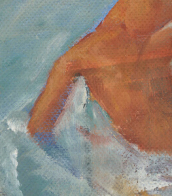

Dmitry Arkadievich Nalbandyan (Russian: Дмитрий Аркадьевич Налбандян) was a Soviet and Armenian painter, whose work earned him significant recognition including the Stalin Prize and the title of People's Artist of the USSR. Born in Tiflis (now Tbilisi, Georgia) in 1906 and passing away in Moscow in 1993, Nalbandyan's contributions to the art world were profound, spanning across genres such as portraiture, landscape, and political art. His education began in Moisei Toidze’s art studio and continued at the Academy of Arts in Tiflis, laying the foundation for a career that would see his works displayed in some of the most prestigious museums globally, including the State Tretyakov Gallery and the Uffizi Gallery in Florence.
Nalbandyan’s art was deeply intertwined with the political and social fabric of his time, with several of his works focusing on significant political figures and moments in Soviet history. For example, his portrait of Joseph Stalin and his depiction of Lenin speaking on the Red Square are indicative of his engagement with the political climate of the USSR. His artworks, characterized by their realism and attention to detail, have been celebrated for capturing the essence of their subjects and the spirit of an era. Notably, Nalbandyan was awarded not only for specific portraits but also for contributions to exhibitions and for paintings that reflected the ethos of friendship, peace, and Soviet achievements.
His artistic legacy is preserved through his contributions to major exhibitions and his inclusion in the collections of museums such as the Russian Museum, highlighting works like "At the Crimea Conference" and "For the Happiness of the People". These pieces, along with others like "Lenin speaking on the Red Square in 1919," underscore Nalbandyan’s role in documenting and interpreting Soviet history through art.
For collectors and experts in art and antiques, Nalbandyan's works offer a window into the Soviet era's visual culture, embodying the aesthetics, ideologies, and historical moments of the time. His paintings, whether they depict political leaders, scenic landscapes, or everyday life, continue to attract attention for their historical significance and artistic merit.
To stay updated on exhibitions, sales, and auctions featuring Dmitry Arkadievich Nalbandyan's art, signing up for updates can provide enthusiasts and collectors with timely information on opportunities to engage with his work. This subscription is an essential tool for those interested in Soviet-era art, offering insights and access to the remarkable legacy of one of the era's most significant artists.


Dmitry Arkadievich Nalbandyan (Russian: Дмитрий Аркадьевич Налбандян) was a Soviet and Armenian painter, whose work earned him significant recognition including the Stalin Prize and the title of People's Artist of the USSR. Born in Tiflis (now Tbilisi, Georgia) in 1906 and passing away in Moscow in 1993, Nalbandyan's contributions to the art world were profound, spanning across genres such as portraiture, landscape, and political art. His education began in Moisei Toidze’s art studio and continued at the Academy of Arts in Tiflis, laying the foundation for a career that would see his works displayed in some of the most prestigious museums globally, including the State Tretyakov Gallery and the Uffizi Gallery in Florence.
Nalbandyan’s art was deeply intertwined with the political and social fabric of his time, with several of his works focusing on significant political figures and moments in Soviet history. For example, his portrait of Joseph Stalin and his depiction of Lenin speaking on the Red Square are indicative of his engagement with the political climate of the USSR. His artworks, characterized by their realism and attention to detail, have been celebrated for capturing the essence of their subjects and the spirit of an era. Notably, Nalbandyan was awarded not only for specific portraits but also for contributions to exhibitions and for paintings that reflected the ethos of friendship, peace, and Soviet achievements.
His artistic legacy is preserved through his contributions to major exhibitions and his inclusion in the collections of museums such as the Russian Museum, highlighting works like "At the Crimea Conference" and "For the Happiness of the People". These pieces, along with others like "Lenin speaking on the Red Square in 1919," underscore Nalbandyan’s role in documenting and interpreting Soviet history through art.
For collectors and experts in art and antiques, Nalbandyan's works offer a window into the Soviet era's visual culture, embodying the aesthetics, ideologies, and historical moments of the time. His paintings, whether they depict political leaders, scenic landscapes, or everyday life, continue to attract attention for their historical significance and artistic merit.
To stay updated on exhibitions, sales, and auctions featuring Dmitry Arkadievich Nalbandyan's art, signing up for updates can provide enthusiasts and collectors with timely information on opportunities to engage with his work. This subscription is an essential tool for those interested in Soviet-era art, offering insights and access to the remarkable legacy of one of the era's most significant artists.

